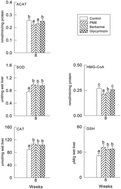Ameliorative effect of Pracparatum mungo extract on high cholesterol diets in hamsters
Abstract
This study was designed to test the lipid-lowering and antioxidative activities of Pracparatum mungo extract (PME), in comparison to its components berberine and glycyrrhizin in cholesterol-fed hamsters. The PME and berberine significantly lowered the atherogenic index compared to glycyrrhizin and the control (P < 0.05). The hepatic HMG-CoA reductase activity was significantly lower in the PME and berberine groups than in the glycyrrhizin group (P < 0.05), while the hepatic ACAT activity was significantly decreased by all treatments with respect to the high cholesterol fed group (P < 0.05). The overall potential of the antioxidant system was significantly enhanced by the PME, berberine and glycyrrhizin supplements as the plasma and hepatic TBARS levels were lowered while the hepatic superoxide dismutase activity and glutathione levels, HMG-CoA reductase, LDL receptor, PPAR, SREBP-2 and CYP7A1 mRNA expressions were increased by the treatments of PME and berberine in comparison with the high cholesterol fed hamsters (P < 0.05). Collectively, these results suggest that the supplementation of PME, berberine and glycyrrhizin increased antioxidant activity in hamsters. Furthermore, we observed that PME and berberine groups promoted the excretion of neutral and acidic sterols (P < 0.05), that could contribute to explain the lower plasma and hepatic cholesterol levels found in the treated animals.


 Please wait while we load your content...
Please wait while we load your content...